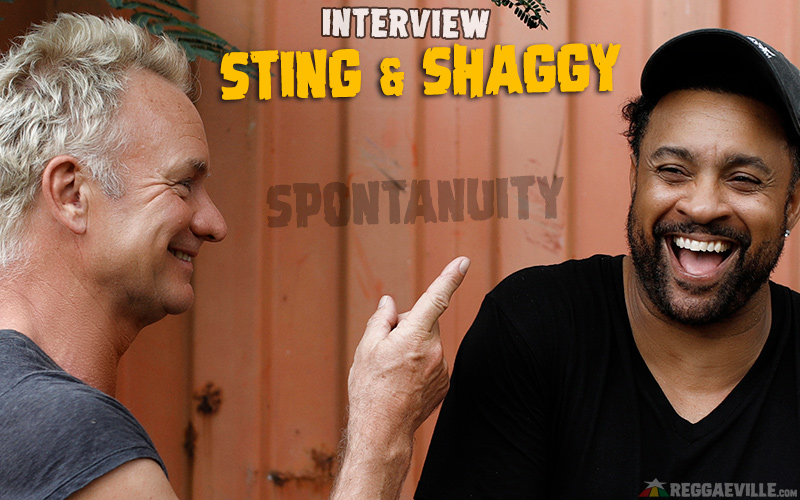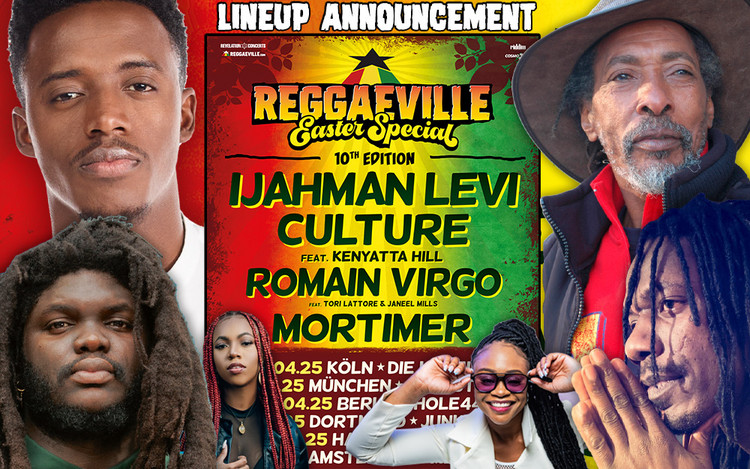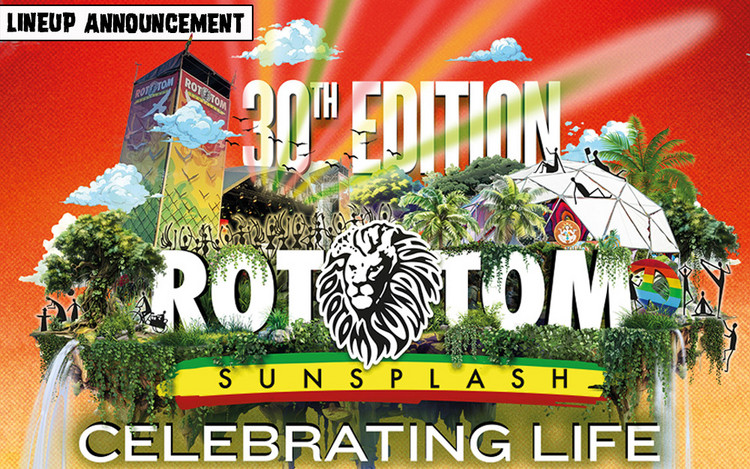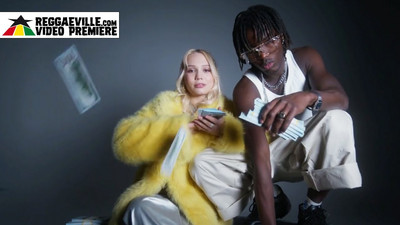Shaggy ADD
Shaggy & Sting - The 44/876 Interview
03/12/2018 by Munchy

It was quite a bomb that dromped when superstars Shaggy and Sting announced to be working on an album together. 44/876 is the title of the surprising record ready to be released on April 20. How they got together, what the extraordinary songs and lyrics inspired, and who the better pool player is, is what they told Munchy in an in-depth Skype interview from New York.
Shaggy and Sting doing an album together. It sounded quite surprising to me at first. Of course, my first question was: how did these two musicians get together? I think in the beginning there was Martin Kierszenbaum. How did he get the ball rolling?
Sting: Martin is my manager and he also used to be Shaggy’s A&R guy, so he knew us both for a long time. He had a suspicion or intuition Shaggy and I would get on, that we’d have a lot in common and his intuition was correct. We met a few times but when we started working together we realized it would be great fun to do more than one song. So we started with Don’t Make Me Wait, which we really enjoyed and then just organically we were in the studio together and I said ‘Why don’t you sing something on this song?’ and then he suggested an idea to me. It happened organically without us really making a hard and fast decision to make a record together. It just happened to materialize around us and our friendship, which is the best way when you think about it.
Most definitely! So there was no point in time where you decided to do an album, everything happened naturally just like that?
Sting: I think at one point it became clear that we did have an album and that was a very exciting moment but before that we were just having fun.
Shaggy: It was just going through the motions of us vibing. It’s just a vibe and an energy. After we had the body of work we were like ‘Oh maybe we should consider putting this out as a project’.
Sting: We gave ourselves a deadline that we have to finish whatever it is by a certain date and that was it. 
How long of a process are we talking?
Both: Six weeks!
Wow, that is quick!
Shaggy: We started part of it, then we went to Jamaica and when we came back from Jamaica we set the deadline. We ended up going hard every day until we got it done.
Sting: What kept us going was the enthusiasm of the people who heard what we were doing. You said you were surprised and excited and that’s the perfect reaction. Everyone was surprised and then they were excited and that feedback made us think ‘Maybe we have something here’, so the surprises continued.
If we look at your musical history Sting, you working with a Reggae artist is not too surprising though. You worked with Sly and Robbie, also with Ziggy Marley previously and the genre has influenced your works in the past. So Lonely, Walking On The Moon and One World are the most remarkable examples, I’d say. Tell me about your love for Reggae and Ska music and its influence on you?
Sting: I lived in England in my young life. We have a very influential West Indian community in England and their music is part of British culture now. So Calypso, Ska, Blue Beat, Caribbean Pop was always part of our consciousness and then when Reggae came with Bob Marley for me in the 70s I recognized something revolutionary. It’s not easy to be revolutionary in Rock’n’Roll but Reggae turned everything on its head. The way that the bass is so important made me very happy, the way the drums are played and the spiritual message, the political message that Marley had, really affected and influenced me greatly. I have a love and respect for it and I also have a debt to pay to it. I owe Reggae music a lot. So to work with an authentic Dancehall/Reggae star like Shaggy is a wonderful thing.
Shaggy: Thank you! 
But the album is not entirely a Reggae record. The term that was used is ‘island-flavored’. The song Waiting For The Break Of Day for example is straight Pop, Dreaming In The USA has the classic Motown beat, 44/876 is Dancehall. Did you both decide to make compromises? Did you see it as a challenge to venture into one another’s genre or how did the sound and music come about and what will we get to hear on 44/876?
Shaggy: I think it was that whole vibe of us. We are both fans of hybrid styles of music. If you listen to my whole discography and my music it has never been raw, straight Reggae. We do love and respect Reggae in its natural form a lot, but if we keep doing that in that form there won’t be much growth to it because I can’t do what my predecessors have done better than them. How am I going to top what Bob Marley has done? How am I going to top what Dennis Brown, Gregory Isaacs or even Sly & Robbie have done? I have to create my own. When looking at Sting’s music it was also that. He didn’t just do raw Rock or raw Reggae. He ventured into so many styles of music to create this hybrid sound so I think that’s what we were both in agreement with and both liked. We kind of morphed that into this record. Although we came in and said we wanted to do an ‘island-flavored’ record, a Reggae record or whatever you might call it, we still wanted to do that hybrid sound. Songs that spark your imagination, ignite emotions. We wanted to send a message with a hybrid sound, where you can catch pieces of different elements of music morphed into one.
Sting: I think the work was to find common ground between us and often ground that we wouldn’t have predicted. I think the album surprised us as well. It’s an interesting process. I would bring in an idea for a song in the morning and I’d say ‘Shaggy give me your interpretation of this theme!’ and then he would write a verse. Or he would come with a song and say to me ‘Add your voice to this, add your view point to this!’. What we ended up with was surprising for many different angles. We produced something that was better than adding one and one. We seemed to got three.
Shaggy: You would think that because we are from two different backgrounds it would be a difficult process. It was one of the easiest processes I’ve been through! There wasn’t much crazy compromising. You have to be on the same wave link with somebody and have the same taste of music. He and I have the same taste in music in a lot of things. For instance, he likes Bill Withers, he is one of his favorite artists and Bill Withers is also one of my favorites. These are things that we had in common, that we just realized, that made it easy. Once we started doing the album it just flowed because there is not anything that he comes with where I would say ‘No, I’m not really into that’. I was rather ‘Wow, this is dope! I like where you are going with this. Interesting!’ and even when it was a new area, a new territory to me I was excited. I wanted to explore it with him and I learned so much from working with him because he just brought me into a whole different atmosphere of music.
Sting: I made him sing! And he can do it so easily, it’s amazing. 
Thank you for bringing that out of Shaggy finally!
Sting: And he made me more spontaneous. What I admire about him is how he creates songs instantly. I have to be private with a pen and a piece of paper and eventually I come out with something. Shaggy makes songs up on the spot. I admire that and I want to emulate that to a certain extend. So he would put me in a place where I had to be almost as spontaneous as him sometimes.
Shaggy: My thing is, if I get tracks I would just think about the melody and lyric, but I didn’t think about the musical part of it, the instrumentation. He got me to pay so much attention to the instrumentation of it and to experiment with the instrumentation of the music. I have been lucky to have made timeless music, records that still play ten and fifteen years after but this guy here has got some decades on me! It’s good to see that process. My thing is to watch him, learn and steal as much as I can from him on how he does it. It was an amazing ride!
Sting: Most Dancehall music is on one harmonic chord, it stays in one place. I’m much more of a traditional songwriter and I like bridges, I like key changes, I like harmonic movement. So Shaggy would bring in an idea with the typical Dancehall groove and then I would mess with it. I’d mess with the chords, change the key, take it every other which way. Which of course drove everybody crazy but it’s a process. So we ended up with some quite traditional structures in songs which is what my contribution is. Shaggy brought the vibe.
Speaking more of instrumentation, the song Dreaming In The USA includes an instrument you rarely hear: the xylophone!
Sting: It’s not a xylophone, it’s a celeste! It is a keyboard that sounds like bells. It’s a chord from Smokey Robinson’s Tears Of A Clown.
Oh wow, right! Lyric wise the song is a love letter to the USA. Was that due to the current situation or did it come about naturally, you two showing your appreciation as being both immigrants to the United States?
Sting: Yes, we are both immigrants and we owe a great deal to this country. We wanted to come here because we loved it. We loved the culture, the music, the movies. But those things are in danger. So Americans need to be encouraged and reminded of what it is that the world loves about America. And it’s not building walls or any of the other crap that comes out. We are trying to remind America what’s great about it. America is great already, it just needs to be reminded. 
The most interesting lyrics I found on your song Crooked Tree, in which you take on two different roles, one of a judge and one of an accused criminal. How did that play come about?
Shaggy (laughing): That whole thing is him by the way! He brought that whole concept to me and I remember reading the lyrics and saying ‘OK, you want me to do what now?!?’. But the minute I tried it, it was me taking these lyrics and flipping them the way I wanted to do it to create that authenticity almost like in the Jamaican Supreme Court with these guys who used to have these head wraps on, yelling ‘Order, order in the court!’. So I just created that whole scene as I remembered the court houses in Jamaica when I was a kid. It’s almost as if some English man came to Jamaica, created some crime and this Jamaican judge who is just like ‘Alright, you t’ink you can come pon my land and do wha’ you wan’ do?! SENTENCE!!!’.
Sting: We messed with the stereotypes. I’m not a felon and I had to play the part of a felon. I’m not sure how successful I am, but Shaggy is a very good judge. (laughter)
Shaggy: Thank you! Yes, we had fun with this one.
How did you decide who would take on which role?
Sting: As I said, I wanted to mess with the stereotypes. I wanted Shaggy to be the high court judge with the white wig and me to be the felon. I think it’s surprising.
Shaggy: Who could imagine me as a judge?
Sting: You’re very judgemental. (laughter)
Shaggy: He is probably right.
Sting: You know that there is a tradition of Reggae songs with that theme, like Judge Dread or Not Guilty.
Shaggy: So there has been more than one of these before but we just made it sexy. We just brought the sexy to it. (laughs)
Shaggy, for your previous album Out Of Many, One Music you worked with Sly Dunbar, possibly the most recorded Reggae drummer, while Sting, you did a lot of work with Vinnie Colaiuta, who is one of the most recorded drummers in Pop, Jazz, Fusion… so who beat the drums on this album?
Sting: A guy called Zach Jones played some of the drums on Dreaming In The USA but most of the drums are programmed.
Shaggy: A lot of the Reggae tracks have live drums though. Sting International (Shaggy’s producer) and his crew came in and did some live drums on them.
What other musicians did you invite to partake in 44/876? I heard a very special bassie from Jamaica played on the record, too. Someone you, Sting, called “a real bass player”. Who was it?
Shaggy (laughs): Did he say that? Oh, you mean Robbie Shakespeare. Yes, Robbie came in but he just came to hang out for a bit, listen some of the tracks and then he caught a vibe on the bass…
Sting: He wanted to play my bass! (Laughter) We used people from our lives. We were very inclusive, we had a couple of lady singers and my daughter wrote one of the songs and she sang with me on Night Shift.
Shaggy: Branford Marsalis also came in and Morgan Heritage are on 44/876 also with Aidonia. Everything happened really organically because we were in the studio, people were in New York and just came by to hang out and we were like ‘Yo, jump on this! Jump on that!’ and it created a vibe. 
Is this how Aidonia came on board of the project?
Shaggy: Yeah. When we did Shaggy & Friends in Jamaica for the Bustamante Hospital for Children Aidonia was on the bill. We just connected there and he was going to be in New York at the same time, so I said ‘Come through!’ and he came through. He listened a couple of songs and actually did vocals on two tracks. He also did a part on To Love And Be Loved but we decided to go with 44/876. So that was all spontaneous.
Okay, because I was imagining Sting in the dance, bussing a blank to Yeah Yeah and being like ‘Yo, we need to get this guy on our record!’...
Shaggy (laughs): He was down there doing that! You see him in the video for Don’t Make Me Wait? That was like a real dance scene that was happening. There is this dance here called Seafood Tuesdays. It’s a hardcore Jamaican Dancehall party in Queens. I’m here to take him there. He has got to come there one night just to hear some blank buss ‘Brap brap brap’ and the whole energy.
Excellent plan! Who else is featured apart from Aidonia. You mentioned Morgan Heritage…
Shaggy: Morgan Heritage is featured on that same track 44/876. They did the hook for us, the chorus and the background vocals. And that was really just it. If you buy the box set of the album, there is a live version of Message In A Bottle with Agent Sasco, and there is also the live version of me and Sting doing Roxanne. There will be four, five live tracks from the Shaggy & Friends show on the edition of the box set. It commemorates and highlights Sting’s first time performing in Jamaica and you can hear him playing to the Jamaican audience and the audience reacting back to him. It was certainly a historic moment in both of our careers.
Speaking of Shaggy & Friends. Sting, that was your first time performing in Jamaica but it was not your first time going to Jamaica. You have been there in the 80s a lot. How did you remember the island? What were your expectations and experiences now?
Sting: I hadn’t been back to Jamaica in 20 years so obviously it’s developed a great deal, especially Kingston. But it’s still the place that I loved and I wished we could have spent more time there. But as you said, I was there a lot in the 80s. I used to hang out at Tuff Gong and on the North shore in Ocho Rios. But it was great to go and play there for the first time. I said to Shaggy ‘You think they will know who I am?’, he said ‘Oh yeah’.
(Laughter)
Shaggy: Boy, did they know who he was. We had one of the biggest crowds ever for Shaggy & Friends. We had about 15,000 people that came in. For the first time we made 100 Million Jamaican Dollars and donated that. What was good about Sting was that unlike other artist who just come, do the concert and leave without doing much interviews, he came and the minute he came off the plane he did a press conference right there at the airport. He greeted the people, went to the hospital, went through all the streets, just soaked up the energy of Jamaica. That is what connected to the Jamaican people. 
Sting: I played dominoes!
Shaggy: Yeah, we went down into the ghettos, met with the people and hung out with them, ate, drank, had a real vibe. Most artists that come don’t do that but Sting came in and did the whole thing. That surprised people because he is a massive superstar and I had artists of lesser status who didn’t want to do shit. And even during the concert most people who are waiting for their showtime are backstage but he was out in the crowd… …
bussing blanks…
Shaggy (laughs): … bussing blanks and meeting people. I think that was the energy that transcended with all the locals. We really appreciated it. And we did it for some good. It was a good opportunity to launch our project, make some money for the hospital and do some good for Jamaica. It all worked out.
You also shot the video for Don’t Make Me Wait in Half Way Tree and downtown on Fleet Street while being there...
Shaggy: We picked a few locations like Half Way Tree and the crew went the day before to shoot in other places like Hellshire beach. They went all over the place. We wanted to capture the essence of Jamaica, the real vibe. One of the strongest things about Jamaica is its culture. To me that is one of our biggest exports. We wanted to highlight that. He says ‘Don’t make me wait to love you’. As much as it is a love song, it’s also a love of Jamaica and the Jamaican culture, the music, the people and their spirit. We wanted to capture and show that, and not in a dark way. There are a lot of videos that come out, that show the ghetto and show it in a very negative way. We wanted to show that it might be very simple life but people are happy. You’re seeing people smiling. You’re seeing children playing. Even though they are in poor neighborhoods, they are not there trying to kill each other. They are in poor neighborhoods trying to live. I’m not saying there is no crime, but show me a place in the world where there isn’t! I think Gil Green (music video director) did a wonderful job. 
How was that for you Sting? Going to Kingston, visiting the inner city, meeting with the people there in the streets?
Sting: It was a great privilege to do that but I went with an advantage: I went with the pope of Jamaica as my escort. He gets a lot of respect deservedly. People know the work he does, they know how serious he is about being an ambassador for Jamaica, so to go there with him was fantastic and it wasn’t like the tourist route at all. It was the real Jamaica. I was happy to be there and to be welcomed. I didn’t expect anything else than that. Jamaicans have always been very warm to me. I have been thoroughly enjoying it and I have a great respect for the island. It is remarkable how influential the culture of the island has been in the world, for such a small island, small population. When you think about music, about sport, it’s incredible what they have done.
Speaking about the video one more time though… The most important question still is: who won the game of pool?
Sting: Do you need to ask?!? He can’t play pool shit. Do you know that Jamaican sports thing? Well, he had a bypass. (Laughter) We’re not competitive though.
Shaggy (laughs): I give him that. I let him win. I was hosting him in my country, it was the only right thing to do.
True! Of course!
Shaggy: There were cameras around, you know. I can’t make the rock star look like he is… you know what I’m saying? It was just the right thing to do.
Sting: You are diplomatic. 
For my final question I would like to look at what is ahead of us apart from the release of the album on the very special date April 20. You are also going to be going on tour together. That is exciting news I got. Please tell me what the fans can expect from the shows.
Sting: We worked together in Minneapolis early in January for a 20-30 minutes spot, where we just blended our stuff together and I think it will be more of that. It won’t be that Shaggy will do a set and I will do a set. It will be totally integrated. That’s kind of risky but it can also be very rewarding and we will have fun. It will be what this project started with in the beginning: fun!
Shaggy: What we are trying to bring to the stage is what we brought to the studio, which is spontanuity.
Sting: Spontanuity?
Shaggy: Did I say that? Spontaneity!
Sting: I like Spontanuity!
Shaggy: Spontaneity… but it could also be spontanuity.
Yeah, I thought you just created a new word!
Sting: He does that all the time!
Shaggy: You know, he is an English teacher and does that to me all the time… So, the spontaneity that we had in the studio, we want to bring it to the stage. And that is the same thing we did, when we were in Minneapolis. It’s just us vibing and merging a whole energy. There are songs that I might just come out and do a freestyle on. There are times when he goes into some bass line, where I’m like ‘Ok, that’s new...’. (Laughter) And it works! For some reason… It might sound a little chaotic but when it comes it’s magic actually. ‘Wow, that works quite well, didn’t it?!’ Once we start doing that anything comes easier, becomes routine after a while. So, it should be fun.
It definitely sounds very exciting and with you two guys being professionals, it can’t be chaotic.
Shaggy: It better won’t. Otherwise it’s going to look real bad…
(Laughter)
Photos by Salvador Ochoa









